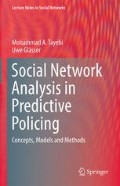Abstract
Co-offending networks are generally extracted from police recorded crime data. For doing so, we need to have a clear view of crime data. In this chapter, we first introduce a unified formal model of crime data as a semantic framework for defining in an unambiguous way the meaning of co-offending networks at an abstract level. Then, we introduce a real-world crime dataset, referred to as BC crime dataset which is used in this book, and the BC co-offending network which is extracted from this dataset. The BC crime dataset represents 5 years of police arrest-data for the regions of the Province of British Columbia which are policed by the RCMP, comprising several million data records.
Access this chapter
Tax calculation will be finalised at checkout
Purchases are for personal use only
Notes
- 1.
The Institute for Canadian Urban Research Studies (ICURS) is a university research center at Simon Fraser University.
- 2.
In implementing the analysis tasks, we used SNAP library which is publicly available at http://snap.stanford.edu/.
References
A.L. Barabasi, R. Albert, Emergence of scaling in random networks. Science 286 (5439), 509–512 (1999)
A.L. Barabasi, H. Jeong, Z. Néda, E. Ravasz, A. Schubert, T. Vicsek, Evolution of the social network of scientific collaborations. Physica A 311, 590–614 (2002)
P. Bonacich, Factoring and weighting approaches to status scores and clique identification. J. Math. Sociol. 2 (1), 113–120 (1972)
S.P. Borgatti, Identifying sets of key players in a social network. Comput. Math. Organ. Theory 12 (1), 21–34 (2006)
P.L. Brantingham, M. Ester, R. Frank, U. Glässer, M.A. Tayebi, Co-offending network mining, in Counterterrorism and Open Source Intelligence, ed. by U.K. Wiil (Springer, Vienna, 2011), pp. 73–102
S. Brin, L. Page, The anatomy of a large-scale hypertextual web search engine. Comput. Netw. ISDN Syst. 30 (1), 107–117 (1998)
G. Bruinsma, W. Bernasco, Criminal groups and transnational illegal markets. Crime Law Soc. Chang. 41 (1), 79–94 (2004)
P.J. Carrington, J. Scott, S. Wasserman, Models and Methods in Social Network Analysis (Cambridge University Press, New York, 2005)
A. Clauset, C.R. Shalizi, M.E.J. Newman, Power-law distributions in empirical data. SIAM Rev. 51 (4), 661–703 (2009)
E.W. Dijkstra, A note on two problems in connexion with graphs. Numer. Math. 1 (1), 269–271 (1959)
P. Erdös, A. Rényi, On random graphs, I. Publ. Math. Debr. 6, 290–297 (1959)
M. Girvan, M.E.J. Newman, Community structure in social and biological networks. Proc. Natl. Acad. Sci. 99 (12), 7821–7826 (2002)
D.M.A. Hussain, D. Ortiz-Arroyo, Locating key actors in social networks using bayes posterior probability framework. Intell. Secur. Inform. 5376, 27–38 (2008)
R. Kumar, J. Novak, A. Tomkins, Structure and evolution of online social networks, in Proceedings of the 12th ACM SIGKDD International Conference on Knowledge Discovery and Data Mining (KDD’06) (2006), pp. 611–617
J. Leskovec, J. Kleinberg, C. Faloutsos, Graph evolution: densification and shrinking diameters. ACM Trans. Knowl. Discov. Data 1 (1), 2 (2007)
X. Liu, J. Bollen, M.L. Nelson, H. Van de Sompel, Co-authorship networks in the digital library research community. Inf. Process. Manag. 41 (6), 1462–1480 (2005)
C.R. Palmer, P.B. Gibbons, C. Faloutsos, Anf: a fast and scalable tool for data mining in massive graphs, in Proceedings of the 8th ACM SIGKDD International Conference on Knowledge discovery and Data Mining (KDD’02) (2002), pp. 81–90
A.J. Reiss Jr., Co-offending and criminal careers. Crime Justice 10, 117–170 (1988)
G. Sabidussi, The centrality index of a graph. Psychometrika 31 (4), 581–603 (1966)
M.K. Sparrow, The application of network analysis to criminal intelligence: an assessment of the prospects. Soc. Netw. 13 (3), 251–274 (1991)
M.A. Tayebi, L. Bakker, U. Glässer, V. Dabbaghian, Locating central actors in co-offending networks, in Proceedings of the 2011 International Conference on Advances in Social Networks Analysis and Mining (ASONAM’11) (2011), pp. 171–179
S. Wasserman, K. Faust, Social Network Analysis: Methods and Applications (Cambridge University Press, New York, 1994)
Author information
Authors and Affiliations
Rights and permissions
Copyright information
© 2016 Springer International Publishing Switzerland
About this chapter
Cite this chapter
Tayebi, M.A., Glässer, U. (2016). Structure of Co-offending Networks. In: Social Network Analysis in Predictive Policing. Lecture Notes in Social Networks. Springer, Cham. https://doi.org/10.1007/978-3-319-41492-8_3
Download citation
DOI: https://doi.org/10.1007/978-3-319-41492-8_3
Published:
Publisher Name: Springer, Cham
Print ISBN: 978-3-319-41491-1
Online ISBN: 978-3-319-41492-8
eBook Packages: Computer ScienceComputer Science (R0)

